This post may contain affiliate links. Please read my privacy policy.
My easy Pad See Ew recipe is a winner with flat rice noodles, savory sauce, and a mix of shrimp, chicken, and vegetables. You’ll have this tasty Thai stir fried flat rice noodle dish ready to enjoy in just 20 minutes!
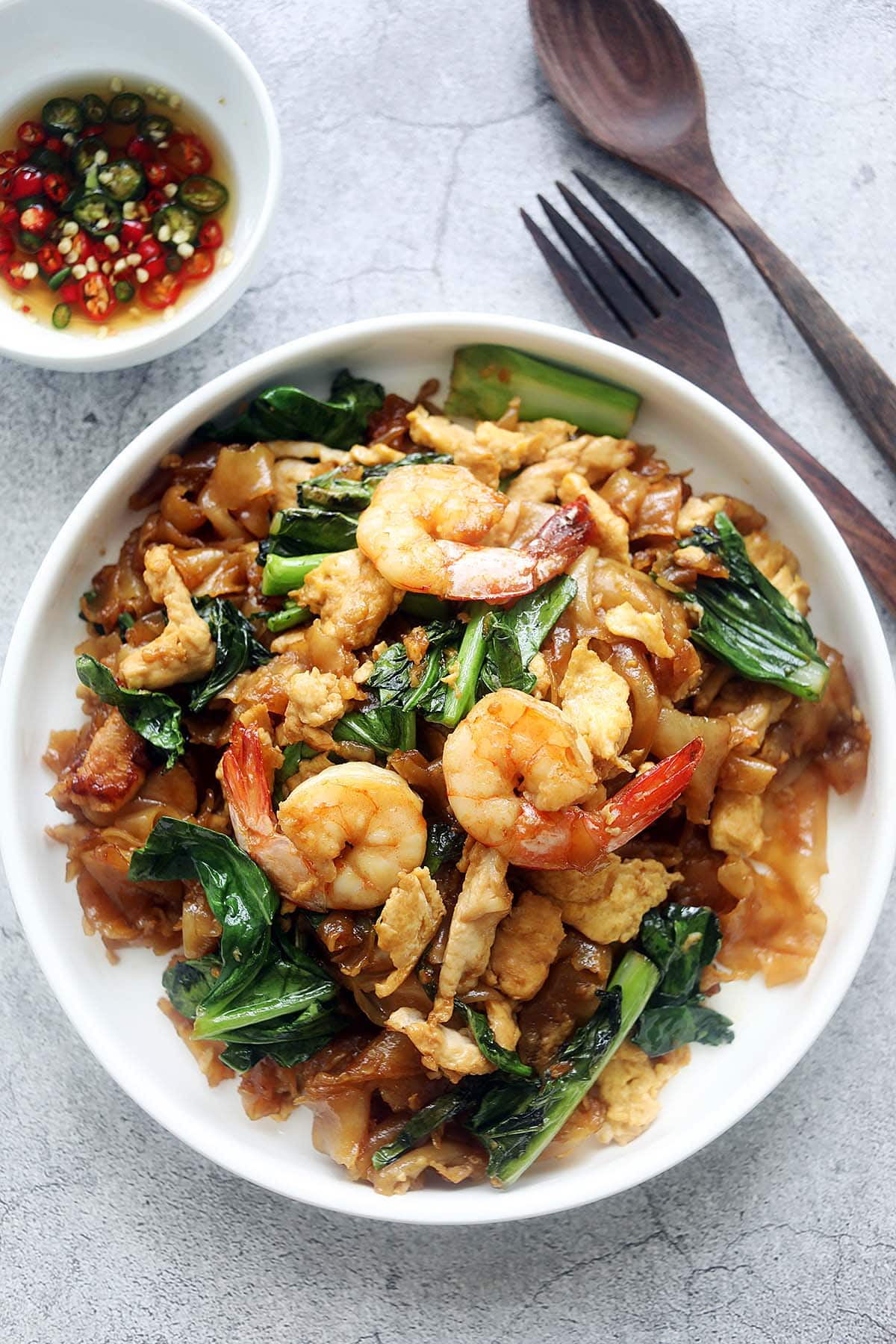
What Is Pad See Ew
Pad See Ew (sometimes spelled Pad Siew, Pad Siu or Phat Si-Io) is a Thai fried rice noodle dish with soy sauce, meat or seafood and vegetables.
Pad means fried and See Ew means soy sauce, so it means fried soy sauce in Thai language. It’s a Chinese recipe that has been adapted to local Thai flavor.
If you go to Thailand, you can find it sold by street vendors all over the country, just like Pad Thai and Pad Kee Mao (Drunken Noodles). Pad Siew is one of my favorite Thai recipes, it’s delicious and utterly satisfying. I can eat it almost every day.
Flat Rice Noodles

Authentic Pad See Ew is easy to find in Thailand, but for the best experience, look for local spots that use fresh ingredients and traditional methods.
Street vendors are known for their tasty Pad Siew. They often set up small stalls or carts along the roadside (called “soi” in Thai) and cook the dish right in front of you. They use a hot wok to stir-fry wide rice noodles with soy sauce, garlic, eggs, veggies, and meat or tofu.
The cooking is quick and lively, filling the air with delicious smells. Each vendor might add their own special touch, so you can enjoy different flavors wherever you go. It’s a fun and authentic way to enjoy this noodle dish.
In this recipe, I’ll show you how to make Pad See Ew at home, with easy-to-follow ingredient guides to help you cook Thai food with ease.
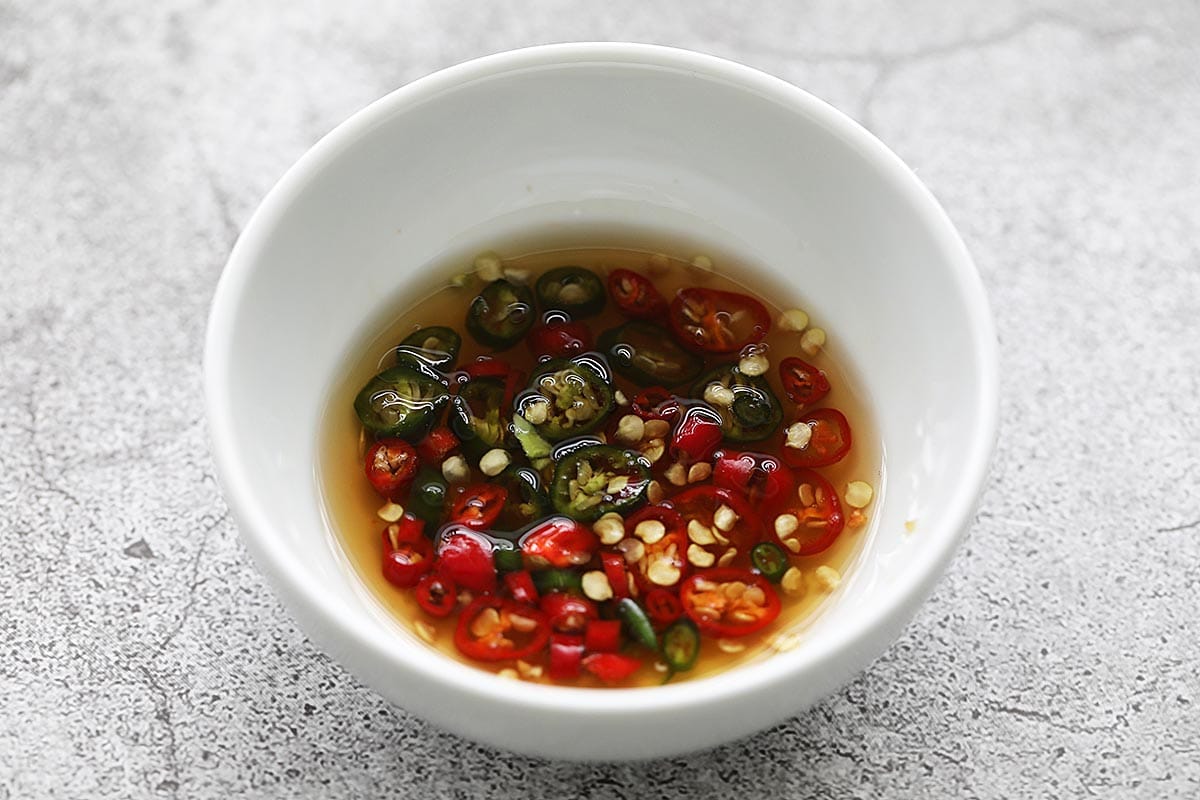
Sidenote: In Thailand, street food often comes with a variety of condiments to customize the flavor according to your preference. These are typically housed in a condiment canister set on the tabletop and may include dried chili powder or chili flakes, sugar, fish sauce, and Thai chilies in vinegar. Sometimes, you might also find lime-based chili sauce and chopped peanuts. My favorite is the Thai chilies condiment (pictured above), which is great with noodle dishes.
Pad See Ew Ingredients

- There are different types of rice noodles used in Thai cooking, for the best recipe, you will need fresh flat rice noodles. They are available fresh at Chinese, Vietnamese, Thai or Asian stores. They are packaged in a plastic bag. The rice noodles are soft, pliable, flat, white in color, and shiny looking as the noodles are coated with oil.
- If fresh rice noodles are not available, you may use dry rice sticks. For this recipe, I recommend wide rice noodles, measuring 3/8″ (1-cm) in width, as pictured below.
- To prep, just follow the package instructions and soak the dried rice noodles in warm water for 30-60 minutes until they become soft and pliable. Rinse the rice noodles with cold water, drain and set them aside for cooking.
- If they’re still a bit firm, quickly cook them in boiling water for 1-2 minutes, then rinse and drain them. And that’s it—your noodles are good to go!
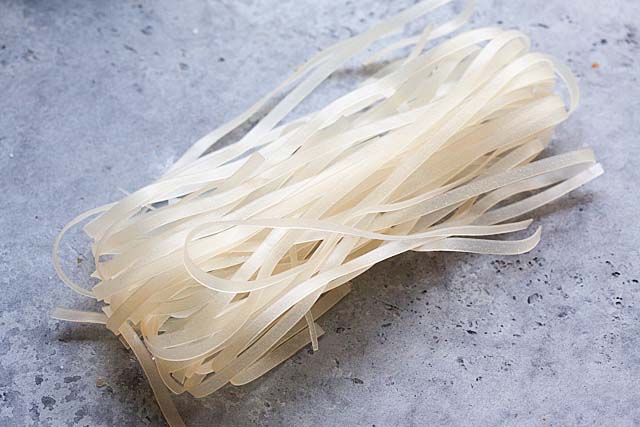
- Chicken – a popular choice of protein for this noodle dish.
- Shrimp – I like a combination of chicken and shrimp.
- Gailan (Chinese broccoli) – When picking gailan/kailan, go for ones with bright, dark green leaves and crunchy, firm stems. Skip any with yellowing leaves or limp, wilted stems.
- Egg – The egg gets scrambled right into the noodles, making them creamy and helping everything stick together.
Shopping Guide: In the United States, you can buy Nona Lim brand fresh Pad See Ew Noodles at Whole Foods.
Pad See Ew Sauce
The sauce calls for a few basic seasonings below. The noodles are stir-fried with the sauce but the dish is actually pretty dry.
- Soy sauce – Pad Siu, which translates to “stir fried soy sauce noodles” in Thai, gets its deep, savory flavor and rich color from soy sauce.
- Thai sweet soy sauce – This sauce gives Pad Siu its signature rich and slightly sweet flavor. It also adds that classic color to the rice noodles.
- Fish sauce – Adds a savory, umami boost.
- Oyster sauce – Adds a savory, slightly sweet taste and makes everything glossy.
- Sugar – Adds a touch of sweetness to balance out the salty and savory flavors from the sauces.
See the recipe card for full information on ingredients.
How To Make Pad See Ew
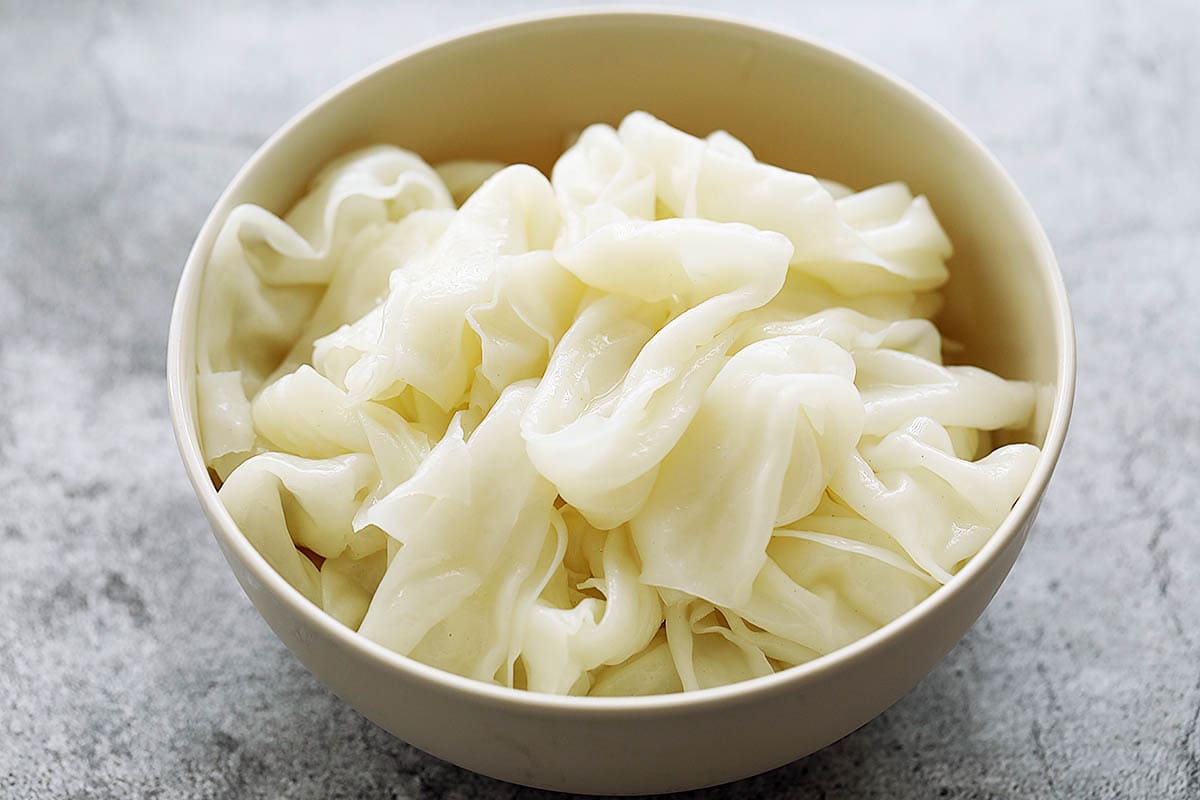
Step 1: Gently loosen the fresh flat rice noodles with your hands to ensure they’re not sticking or clumping together. If you are using dry rice stick noodles, cook them according to the package directions. Drain them in a colander and rinse under cold running water until the noodles are cool. Set aside to drain.
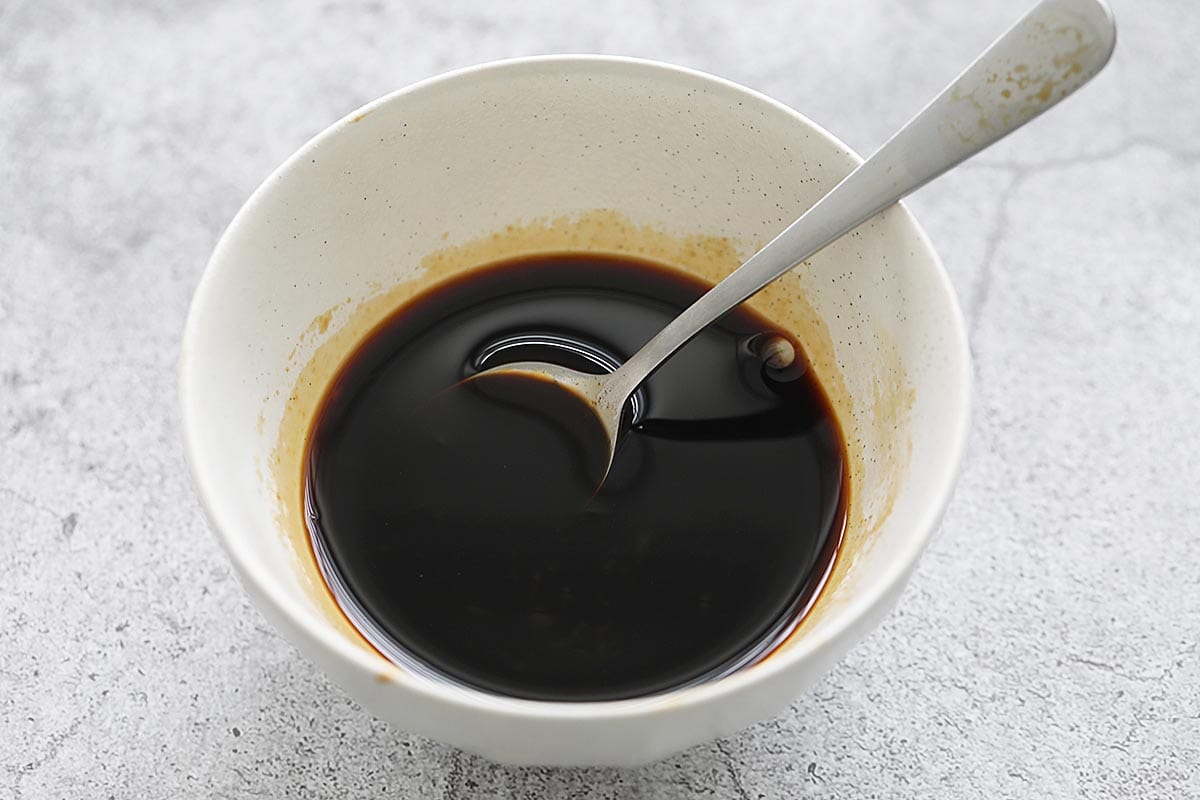
Step 2: Mix all the seasoning ingredients in a small bowl and set aside.

Step 3: Heat oil in a wok or skillet over high heat. Add garlic and stir fry until fragrant. Add chicken and shrimp, and keep stirring until they change color. Then, add the rice noodles and Chinese broccoli. Stir everything together, add the seasonings, and continue stirring until well mixed.
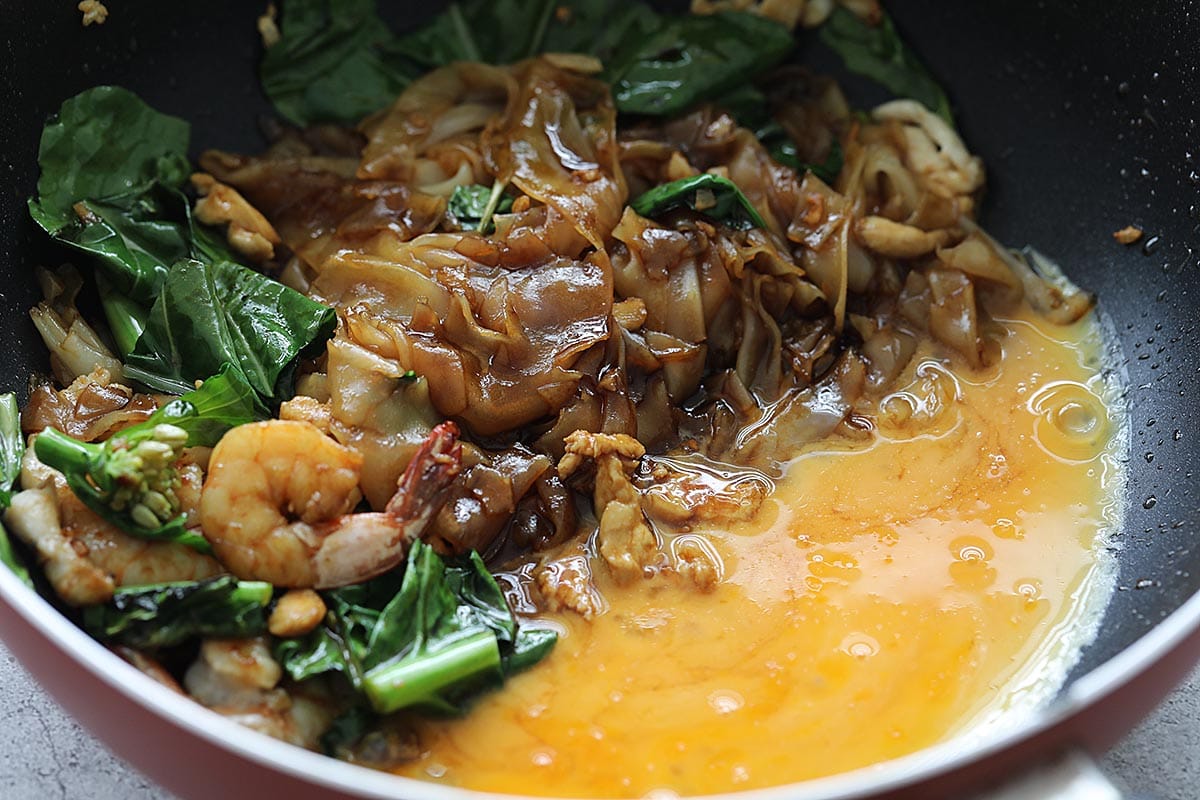
Step 4: Push the noodles to one side of the pan and add the beaten eggs, adding more oil if needed. Cook the eggs until they’re set, then stir them into the noodles to combine everything well.
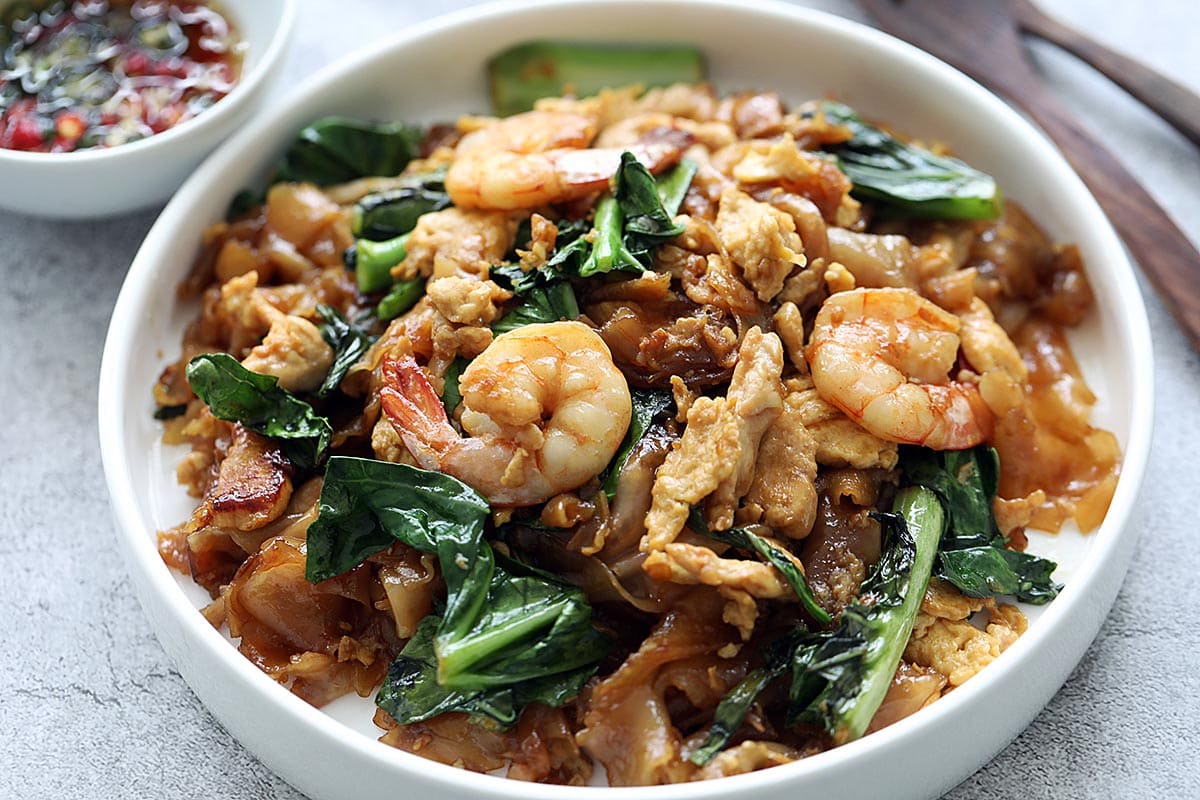
Step 5: Dish out and serve immediately with cut Thai chilies. Repeat the same steps for the second portion.
Helpful Tips For Home Cooks
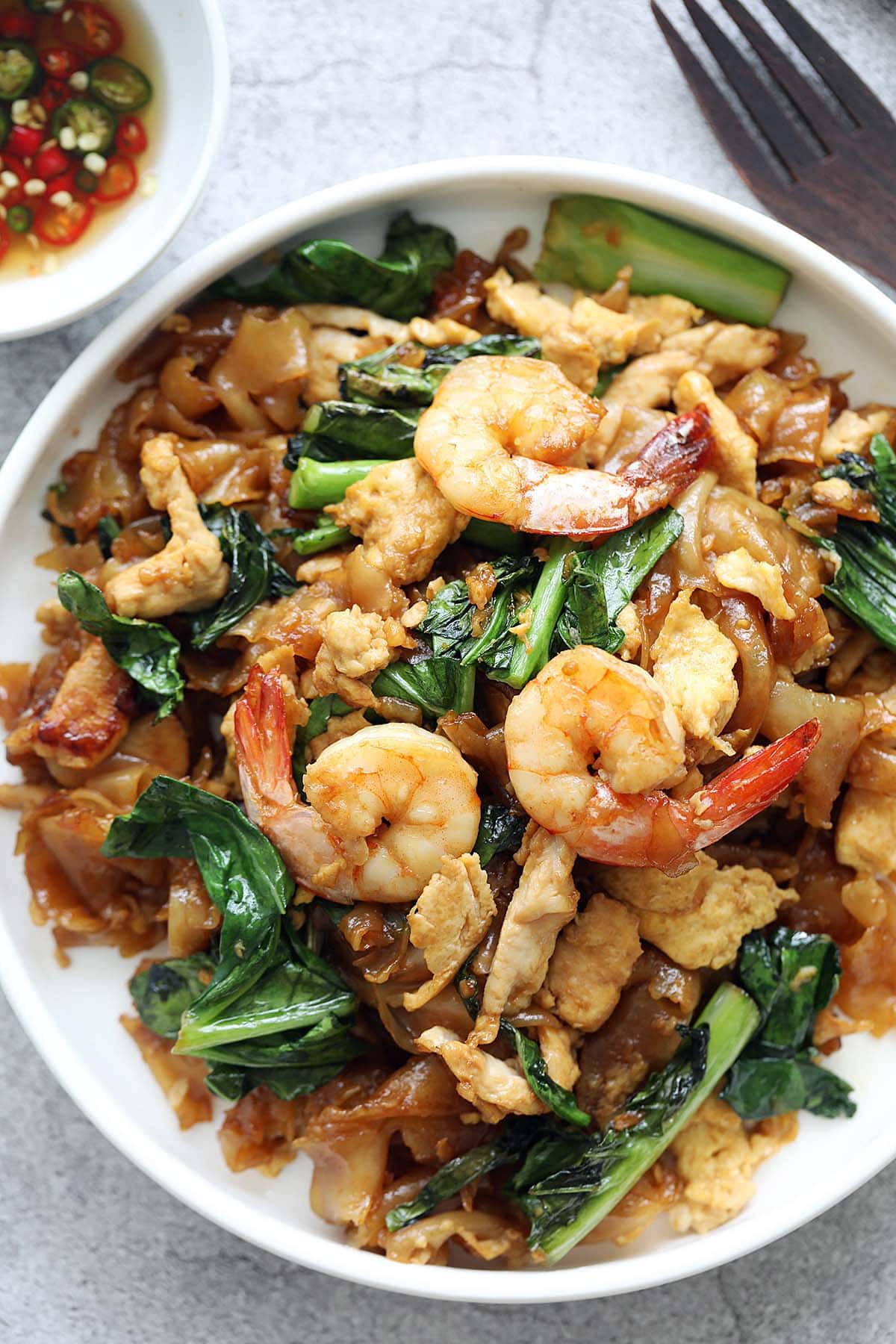
- This is a quick, easy, tried-and-tested Pad Siew recipe. You will need garlic, chicken, shrimp, rice noodles and the seasonings above.
- For the best results, stir fry the noodles in a hot and well-seasoned wok. If you don’t have a wok, you can make the noodles in a skillet. High heat is very important to flash cook and stir fry the noodles.
- I love eggs in my Pad Siu, which you can add during the cooking process. You can certainly make it without eggs.
- If you want to make a vegetarian or vegan version of the recipe, you can skip the chicken and replace with tofu. For the sauce, you can use soy sauce instead of fish sauce and oyster sauce. For extra flavors, you may add Golden Mountain Seasoning Sauce.
Frequently Asked Questions
Even though both uses wide flat rice noodles, Pad See Ew is sweet and savory made with wide rice noodles, garlic, soy sauce, and vegetables like Chinese broccoli. In contrast, Pad Kee Mao, also known as Drunken Noodles, is spicier and stir fried with Thai holy basil, chilies, giving it a bold and aromatic flavor. The former are often slightly charred, with a slightly smoky flavor.
Yes! While chicken and shrimp are popular choices, you can substitute them with beef, tofu, or your favorite protein.
To keep your noodles from sticking, stir fry them quickly and add a splash of water if they start to dry out. Make sure your pan is hot and don’t overcrowd it, which also helps keep things from sticking.
If your noodles are breaking apart, it might be from overcooking or too much stirring. Be gentle with the noodles and keep the cooking time short to keep them intact.
Store any leftovers in an airtight container in the fridge. They should be eaten within 2 days.
Reheat it in a hot pan or wok with a little bit of oil. Avoid using the microwave as it can make the noodles soggy.
This recipe is only 476 calories per serving.
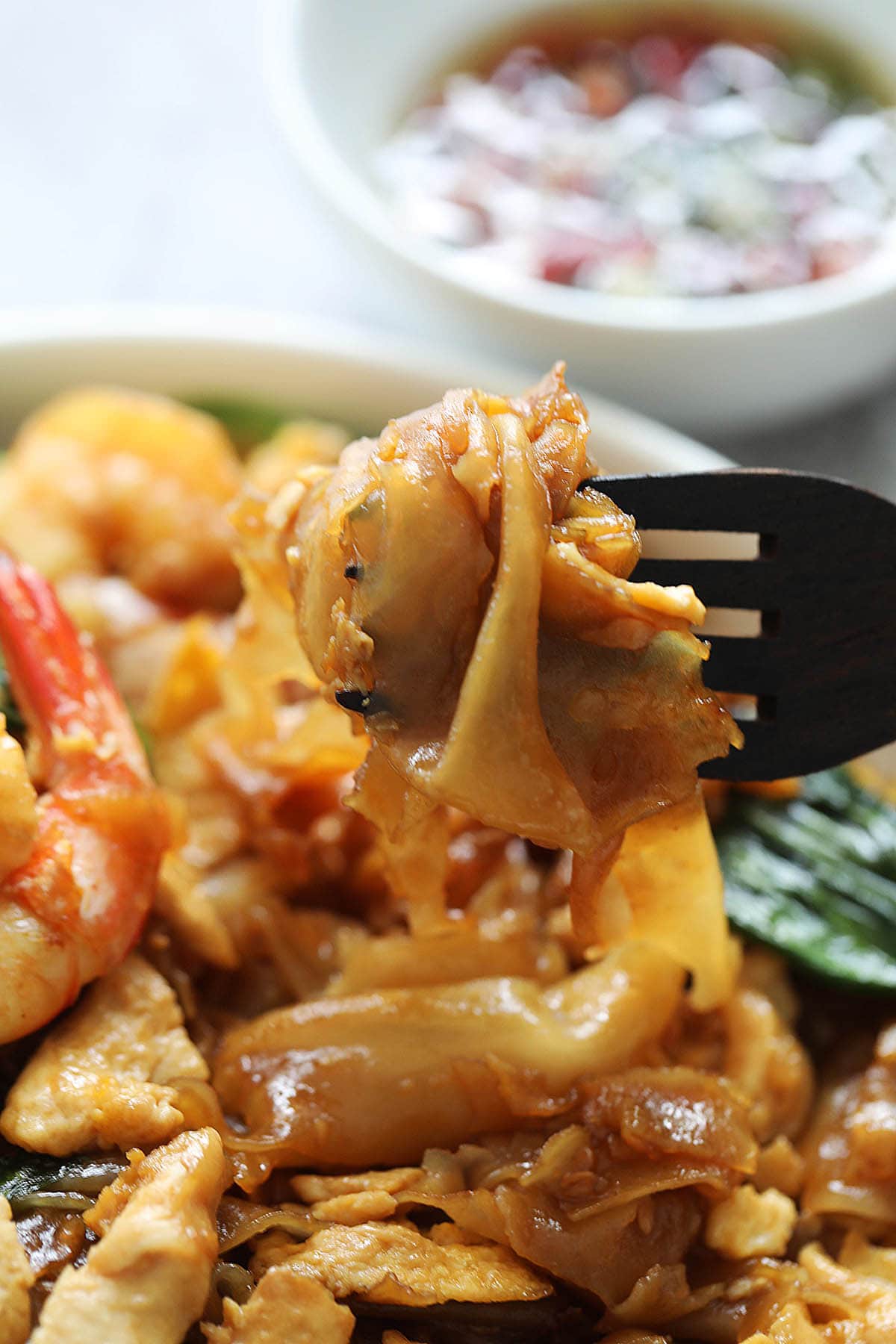
What To Serve With This Recipe
This Thai stir fried rice noodles is best served alone or with a main dish (such as Green Curry) or appetizers. For a wholesome Thai meal at home , I recommend pairing it with the following recipes.
Additionally, feel free to explore my other authentic Thai recipes, such as Tom Yum, Pad Thai, Green Curry, and Thai Cucumber Salad next. They are all amazing and taste just like the ones in Bangkok!
I hope you enjoy this post as much as I do. If you try my recipe, please leave a comment and consider giving it a 5-star rating. For more easy and delicious recipes, explore my Recipe Index, and stay updated by subscribing to my newsletter and following me on Facebook, Pinterest, and Instagram for new updates.
Other Recipes You Might Like
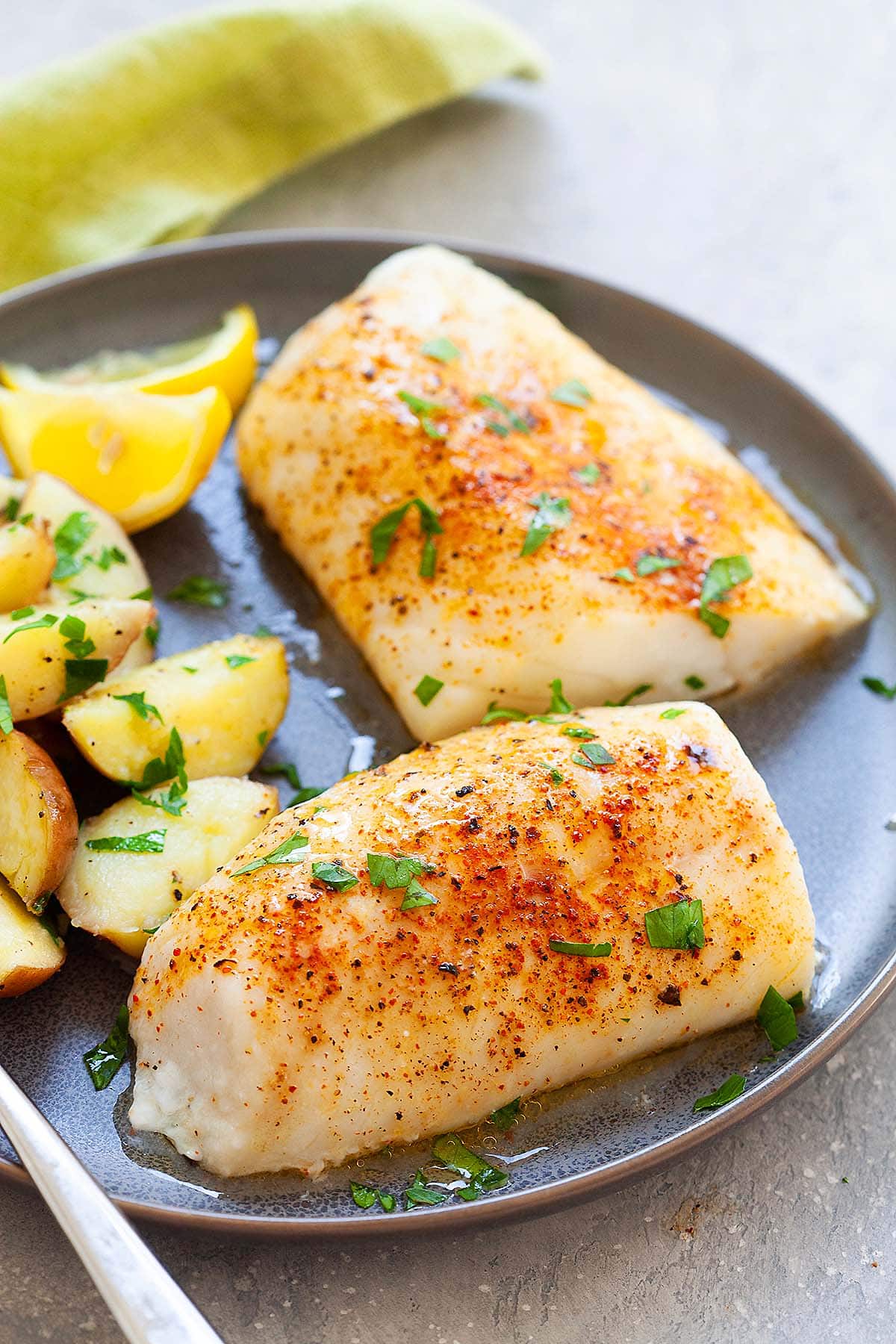
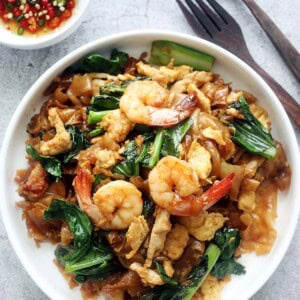
Pad See Ew Recipe
Ingredients
- 4 tablespoons oil
- 4 cloves garlic, minced
- 4 oz (125g) boneless and skinless chicken breast, cut into thin pieces
- 4 oz (125g) shrimp, 6 medium-sized shrimp, peeled and deveined
- 1 lb. (450g) fresh flat rice noodles, or 8 oz. (225g) dry wide rice sticks
- 6 oz. (175g) Chinese broccoli , (Gailan or Kailan), cut into pieces
- 2 eggs, beaten
Seasonings:
- 2 tablespoons soy sauce
- 1 tablespoon oyster sauce
- 2 tablespoons fish sauce
- 3 tablespoons sweet soy sauce
- sugar, to taste, optional
Instructions
- Gently loosen the fresh flat rice noodles with your hands to ensure they’re not sticking or clumping together. If you are using dry rice stick noodles, cook them according to the package directions. Drain them in a colander and rinse under cold running water until the noodles are cool. Set aside to drain.
- Mix all the seasoning ingredients in a small bowl and set aside.
- Divide the noodles, all ingredients, and the Seasoning sauce into two portions. Heat oil in a wok or skillet over high heat. Add garlic and stir fry until fragrant. Add chicken and shrimp, and keep stirring until they change color. Then, add the rice noodles and Chinese broccoli. Stir everything together, add the seasonings, and continue stirring until well mixed.
- Push the noodles to one side of the pan and add the beaten eggs, adding more oil if needed. Cook the eggs until they’re set, then stir them into the noodles to combine everything well.
- Dish out and serve immediately with cut Thai chilies. Repeat the same steps for the second portion.
Video
Notes
- This is a quick, easy tried-and-tested Pad Siew recipe. You will need garlic, chicken, rice noodles and the seasonings above.
- For the best results, stir fry the noodles in a hot and well-seasoned wok. If you don’t have a wok, you can make the noodles in a skillet. High heat is very important to flash cook and stir fry the noodles.
- I love eggs in my Pad Siu, which you can add during the cooking process. You can certainly make it without eggs.
- If you want to make a vegetarian or vegan version of the recipe, you can skip the chicken and replace with tofu. For the sauce, you can use soy sauce instead of fish sauce and oyster sauce.
Nutrition
Nutrition information is automatically calculated, so should only be used as an approximation.
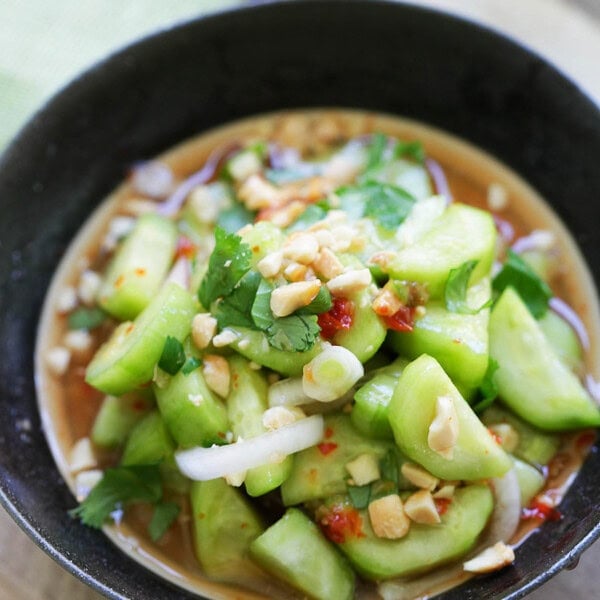

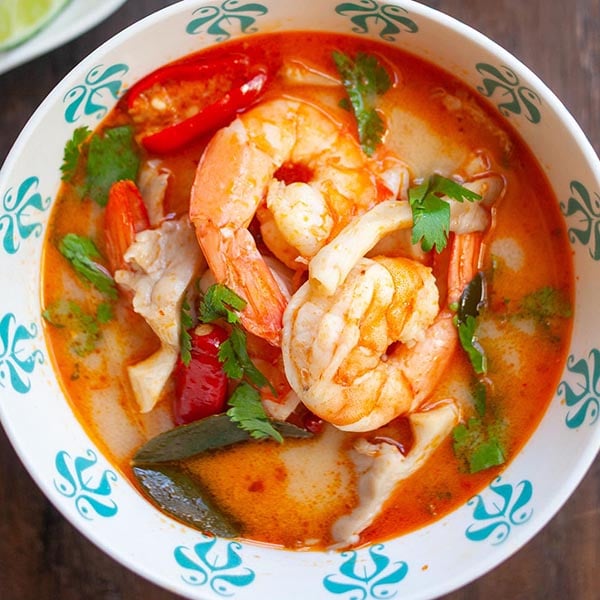







What is the reason for cooking 2 separate portions? Is it not advisable to cook both portions together?
It’s better this way, just like how it’s done in Thailand. If you want to cook two portions into one, you can. Trust me, it will taste better when it’s cooked one portion and then the next.
What are the red spices in the small ramekin? I see them in the photo but they were not listed as ingredients.
Chili powder is often provided on the table for diners, in restaurants in Thailand. It’s optional and for people who wants some extra heat.
Hi, when u say sweet soy sauce ~ can I use kecap Manis?? I always add extra kikkoman soy sauce with it. Is that ok??? I’m so gonna make this & eat it with sambal oeleck (my fave).
Thank god they started selling all these in Australia :)
Yes it’s kecap manis.
I am looking for the best way to cook dry rice noodles. I have had a bunch for a while. I want to use them in this recipe. Do I boil them just like pasta?
Read the instructions on the packaging.
There aren’t any. I had a 4 bunches I put in a container. I apparently did not keep instructions. I read somewhere you can just put in hot water for 10 minutes and that is all. What do you think?
Just cook in boiling water like it’s spaghetti. Cook until al dente.
Thanks I will try that.
Just soak in hot water for 20 mins and then rinse and drain. The noodles will be al dente when you stir fry and more chewy.
So I could bring water to a boil, add noodles, turn off burner and use in 20 minutes? I can do the
Great simple make-at-home pad see ew! I used the sauce on stir fried veggies. Turned out tasty!
Awesome!
Delicious! I didn’t have sweet soy sauce or Chinese broccoli, so I added an extra 1/2 tbs of sugar and heated the sauce to dissolve it. For the vegetable, I used thick leaves from a head of cauliflower and sliced them very thin. Worked out well.